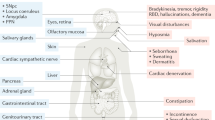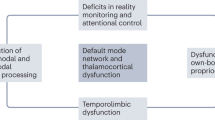Abstract
Parkinson’s disease (PD) involves the degeneration of dopaminergic (DA) neurons in the substantia nigra pars compacta (SNc) that is thought to cause the classical motor symptoms of this disease. However, motivational and affective impairments are also often observed in PD patients. These are usually attributed to a psychological reaction to the general motor impairment and to a loss of some of the neurons within the ventral tegmental area (VTA). We induced selective lesions of the VTA and SNc DA neurons that did not provoke motor deficits, and showed that bilateral dopamine loss within the SNc, but not within the VTA, induces motivational deficits and affective impairments that mimicked the symptoms of PD patients. Thus, motivational and affective deficits are a core impairment of PD, as they stem from the loss of the major group of neurons that degenerates in this disease (DA SNc neurons) and are independent of motor deficits.
This is a preview of subscription content, access via your institution
Access options
Subscribe to this journal
Receive 12 print issues and online access
$259.00 per year
only $21.58 per issue
Buy this article
- Purchase on Springer Link
- Instant access to full article PDF
Prices may be subject to local taxes which are calculated during checkout






Similar content being viewed by others
References
Damier P, Hirsch EC, Agid Y, Graybiel AM . The substantia nigra of the human brain. II. Patterns of loss of dopamine-containing neurons in Parkinson's disease. Brain 1999; 122 (Pt 8): 1437–1448.
Bjorklund A, Dunnett SB . Dopamine neuron systems in the brain: an update. Trends Neurosci 2007; 30: 194–202.
Chaudhuri KR, Schapira AH . Non-motor symptoms of Parkinson's disease: dopaminergic pathophysiology and treatment. Lancet Neurol 2009; 8: 464–474.
Krack P, Hariz MI, Baunez C, Guridi J, Obeso JA . Deep brain stimulation: from neurology to psychiatry? Trends Neurosci 2010; 33: 474–484.
Thobois S, Ardouin C, Lhommée E, Klinger H, Lagrange C, Xie J et al. Non-motor dopamine withdrawal syndrome after surgery for Parkinson's disease: predictors and underlying mesolimbic denervation. Brain 2010; 133: 1111–1127.
Le Moal M, Simon H . Mesocorticolimbic dopaminergic network: functional and regulatory roles. Physiol Rev 1991; 71: 155–234.
Nieoullon A, Coquerel A . Dopamine: a key regulator to adapt action, emotion, motivation and cognition. Curr Opin Neurol 2003; 16 (Suppl 2): S3–S9.
Koob GF, Simon H, Herman JP, Le Moal M . Neuroleptic-like disruption of the conditioned avoidance response requires destruction of both the mesolimbic and nigrostriatal dopamine systems. Brain Res 1984; 303: 319–329.
Lindgren HS, Dunnett SB . Cognitive dysfunction and depression in Parkinson's disease: what can be learned from rodent models? Eur J Neurosci 2012; 35: 1894–1907.
Schwarting RK, Huston JP . Unilateral 6-hydroxydopamine lesions of meso-striatal dopamine neurons and their physiological sequelae. Prog Neurobiol 1996; 49: 215–266.
Paxinos G, Watson C . The Rat Brain in Stereotaxic Coordinates. Elesvier Academic Press: San Diego, 1998.
Boulet S, Lacombe E, Carcenac C, Feuerstein C, Sgambato-Faure V, Poupard A et al. Subthalamic stimulation-induced forelimb dyskinesias are linked to an increase in glutamate levels in the substantia nigra pars reticulata. J Neurosci 2006; 26: 10768–10776.
Voorn P, Vanderschuren LJ, Groenewegen HJ, Robbins TW, Pennartz CM . Putting a spin on the dorsal-ventral divide of the striatum. Trends Neurosci 2004; 27: 468–474.
Dentresangle C, Le Cavorsin M, Savasta M, Leviel V . Increased extracellular DA and normal evoked DA release in the rat striatum after a partial lesion of the substantia nigra. Brain Res 2001; 893: 178–185.
Olsson M, Nikkhah G, Bentlage C, Bjorklund A . Forelimb akinesia in the rat Parkinson model: differential effects of dopamine agonists and nigral transplants as assessed by a new stepping test. J Neurosci 1995; 15: 3863–3875.
Takaki E, Fujimoto M, Sugahara K, Nakahari T, Yonemura S, Tanaka Y et al. Maintenance of olfactory neurogenesis requires HSF1, a major heat shock transcription factor in mice. J Biol Chem 2006; 281: 4931–4937.
Lelan F, Boyer C, Thinard R, Rémy S, Usal C, Tesson L et al. Effects of human alpha-synuclein A53T-A30P mutations on svz and local olfactory bulb cell proliferation in a transgenic rat model of Parkinson disease. Parkinsons Dis 2011; 2011: 987084.
Pecina S, Cagniard B, Berridge KC, Aldridge JW, Zhuang X . Hyperdopaminergic mutant mice have higher ‘wanting’ but not ‘liking’ for sweet rewards. J Neurosci 2003; 23: 9395–9402.
Baunez C, Dias C, Cador M, Amalric M . The subthalamic nucleus exerts opposite control on cocaine and 'natural' rewards. Nat Neurosci 2005; 8: 484–489.
Carnicella S, Kharazia V, Jeanblanc J, Janak PH, Ron D . GDNF is a fast-acting potent inhibitor of alcohol consumption and relapse. Proc Natl Acad Sci USA 2008; 105: 8114–8119.
Richardson NR, Roberts DC . Progressive ratio schedules in drug self-administration studies in rats: a method to evaluate reinforcing efficacy. J Neurosci Methods 1996; 66: 1–11.
Belin D, Berson N, Balado E, Piazza PV, Deroche-Gamonet V . High-novelty-preference rats are predisposed to compulsive cocaine self-administration. Neuropsychopharmacology 2011; 36: 569–579.
File SE, Hyde JR . Can social interaction be used to measure anxiety? Br J Pharmacol 1978; 62: 19–24.
Kish SJ, Shannak K, Hornykiewicz O . Uneven pattern of dopamine loss in the striatum of patients with idiopathic Parkinson's disease. Pathophysiologic and clinical implications. N Engl J Med 1988; 318: 876–880.
Kirik D, Rosenblad C, Bjorklund A . Characterization of behavioral and neurodegenerative changes following partial lesions of the nigrostriatal dopamine system induced by intrastriatal 6-hydroxydopamine in the rat. Exp Neurol 1998; 152: 259–277.
Marin RS . Apathy: a neuropsychiatric syndrome. J Neuropsychiatry Clin Neurosci 1991; 3: 243–254.
Levy R, Dubois B . Apathy and the functional anatomy of the prefrontal cortex-basal ganglia circuits. Cereb Cortex 2006; 16: 916–928.
Schmidt L, d'Arc BF, Lafargue G, Galanaud D, Czernecki V, Grabli D et al. Disconnecting force from money: effects of basal ganglia damage on incentive motivation. Brain 2008; 131: 1303–1310.
Czernecki V, Schüpbach M, Yaici S, Lévy R, Bardinet E, Yelnik J et al. Apathy following subthalamic stimulation in Parkinson disease: a dopamine responsive symptom. Mov Disord 2008; 23: 964–969.
Ettenberg A . Opponent process properties of self-administered cocaine. Neurosci Biobehav Rev 2004; 27: 721–728.
Hodos W . Progressive ratio as a measure of reward strength. Science 1961; 134: 943–944.
Deroche-Gamonet V, Piat F, Le Moal M, Piazza PV . Influence of cue-conditioning on acquisition, maintenance and relapse of cocaine intravenous self-administration. Eur J Neurosci 2002; 15: 1363–1370.
Olds J . Drives and Reinforcements: Behavioral Studies of Hypothalamic Functions. Raven Press: New York, 1977).
Palmiter RD . Dopamine signaling in the dorsal striatum is essential for motivated behaviors: lessons from dopamine-deficient mice. Ann NY Acad Sci 2008; 1129: 35–46.
Tadaiesky MT, Dombrowski PA, Figueiredo CP, Cargnin-Ferreira E, Da Cunha C, Takahashi RN . Emotional, cognitive and neurochemical alterations in a premotor stage model of Parkinson's disease. Neuroscience 2008; 156: 830–840.
Brown CA, Campbell MC, Karimi M, Tabbal SD, Loftin SK, Tian LL et al. Dopamine pathway loss in nucleus accumbens and ventral tegmental area predicts apathetic behavior in MPTP-lesioned monkeys. Exp Neurol 2012; 236: 190–197.
Belin D, Jonkman S, Dickinson A, Robbins TW, Everitt BJ . Parallel and interactive learning processes within the basal ganglia: relevance for the understanding of addiction. Behav Brain Res 2009; 199: 89–102.
Bromberg-Martin ES, Matsumoto M, Hikosaka O . Dopamine in motivational control: rewarding, aversive, and alerting. Neuron 2010; 68: 815–834.
Ikemoto S . Dopamine reward circuitry: two projection systems from the ventral midbrain to the nucleus accumbens-olfactory tubercle complex. Brain Res Rev 2007; 56: 27–78.
Wise RA . Roles for nigrostriatal—not just mesocorticolimbic—dopamine in reward and addiction. Trends Neurosci 2009; 32: 517–524.
Yin HH, Knowlton BJ . The role of the basal ganglia in habit formation. Nat Rev Neurosci 2006; 7: 464–476.
Sokoloff P, Diaz J, Le Foll B, Guillin O, Leriche L, Bezard E et al. The dopamine D3 receptor: a therapeutic target for the treatment of neuropsychiatric disorders. CNS Neurol Disord Drug Targets 2006; 5: 25–43.
Aarsland D, Pahlhagen S, Ballard CG, Ehrt U, Svenningsson P . Depression in Parkinson disease—epidemiology, mechanisms and management. Nat Rev Neurol 2011; 8: 35–47.
Barone P . Treatment of depressive symptoms in Parkinson's disease. Eur J Neurol 2011; 18 (Suppl 1): 11–15.
Barnhart WJ, Makela EH, Latocha MJ . SSRI-induced apathy syndrome: a clinical review. J Psychiatr Pract 2004; 10: 196–199.
Adell A, Artigas F . The somatodendritic release of dopamine in the ventral tegmental area and its regulation by afferent transmitter systems. Neurosci Biobehav Rev 2004; 28: 415–431.
Barone P . Neurotransmission in Parkinson's disease: beyond dopamine. Eur J Neurol 2010; 17: 364–376.
Navailles S, Benazzouz A, Bioulac B, Gross C, De Deurwaerdere P . High-frequency stimulation of the subthalamic nucleus and L-3,4-dihydroxyphenylalanine inhibit in vivo serotonin release in the prefrontal cortex and hippocampus in a rat model of Parkinson's disease. J Neurosci 2010; 30: 2356–2364.
Paxinos G, Watson C . The Rat Brain in Stereotaxic Coordinates. Elesvier Academic Press: San Diego, 2005.
Acknowledgements
This work was supported by the Institut National de la Santé et de la Recherche Médicale, Fondation NeuroDis, Association France Parkinson, Ministère de la Recherche et de la technologie (MRT), Région Rhône-Alpes (ARC n°2) and Université Joseph Fourier. We would also like to thank Maurice Demattéis and Paul Krack for helpful discussions.
Author contributions
GD, SC and MS were responsible for overall study design. GD, SC, MF and SB carried out the stereotaxic surgeries and the post-surgery monitoring of the animals. CC, GD and SC carried out the neuroanatomical analysis and characterization of the lesions. SC and GD performed the experiment for the neurochemical characterization of the lesion. AB carried out the HPLC process and analysis. SC and GD carried out the behavioral experiments and analysis. GD, SC and MS wrote the paper with the help of the other authors.
Author information
Authors and Affiliations
Corresponding author
Ethics declarations
Competing interests
The authors declare no conflict of interest.
Additional information
Supplementary Information accompanies the paper on the Molecular Psychiatry website
Rights and permissions
About this article
Cite this article
Drui, G., Carnicella, S., Carcenac, C. et al. Loss of dopaminergic nigrostriatal neurons accounts for the motivational and affective deficits in Parkinson’s disease. Mol Psychiatry 19, 358–367 (2014). https://doi.org/10.1038/mp.2013.3
Received:
Revised:
Accepted:
Published:
Issue Date:
DOI: https://doi.org/10.1038/mp.2013.3
Keywords
This article is cited by
-
Anxiety in synucleinopathies: neuronal circuitry, underlying pathomechanisms and current therapeutic strategies
npj Parkinson's Disease (2023)
-
Behavioral, neural and ultrastructural alterations in a graded-dose 6-OHDA mouse model of early-stage Parkinson's disease
Scientific Reports (2023)
-
Hypodopaminergic state of the nigrostriatal pathway drives compulsive alcohol use
Molecular Psychiatry (2023)
-
Human α-synuclein overexpression in mouse serotonin neurons triggers a depressive-like phenotype. Rescue by oligonucleotide therapy
Translational Psychiatry (2022)
-
Re-routing Metabolism by the Mitochondrial Pyruvate Carrier Inhibitor MSDC-0160 Attenuates Neurodegeneration in a Rat Model of Parkinson’s Disease
Molecular Neurobiology (2022)



